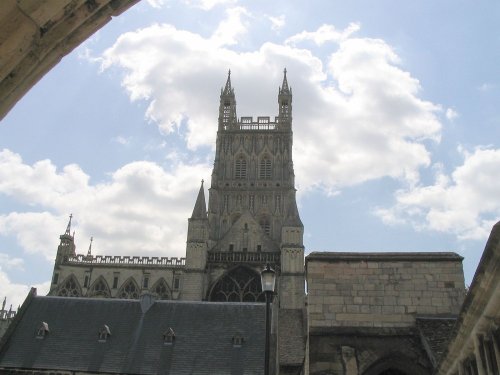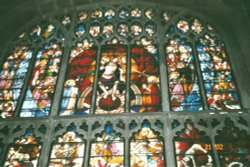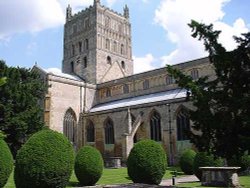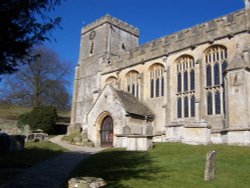Please login or click here to join.
Forgot Password? Click Here to reset pasword

Whether you regard them as places of deep spiritual importance, or merely as interesting buildings housing works of art - or something in between - England's churches are without doubt some of the most fascinating examples of architecture and art through the ages.
Gloucestershire historically was one of England's richest counties, thanks mainly to its wool industry, and it shows in its church building. Certainly for some of the largest, grandest churches and cathedrals, benefactors were prepared to pay large sums of money to attract the most skilled architects, glass designers, wood carvers and artists. These buildings are now virtual treasure houses, showcasing some of the country's finest works. The most well-known of these must of course be Gloucester Cathedral, which attracts over quarter of a million visitors each year. Started from humble beginnings, the site where the great cathedral now stands was home to a small Saxon religious community as far back as the 7th century. It wasn't until late in the 11th century though that the cathedral, originally built and consecrated as an abbey, was founded. The final resting place of Edward II - appropriately enough, since he was murdered in nearby Berkeley Castle - the cathedral underwent rebuilding in the 14th and 15th centuries, with the west side being remodelled, and the tower added. It was dissolved as an abbey and then re-established as a cathedral by Henry VIII in 1541.
 The 18th and 19th centuries both saw restoration work being carried out particularly over a twenty-five year period in the mid 1800s, so there is a strong Victorian influence apparent. It is a magnificent building, with stunning architecture inside and out. The nave with its massive columns is particularly impressive as is the 14th century east window, which, at almost 80 feet long, is apparently the largest of its kind in the country. In fact the cathedral is so impressive that it is almost unreal - so much so that it was chosen to portray Hogwarts in the famous Harry Potter films.
The 18th and 19th centuries both saw restoration work being carried out particularly over a twenty-five year period in the mid 1800s, so there is a strong Victorian influence apparent. It is a magnificent building, with stunning architecture inside and out. The nave with its massive columns is particularly impressive as is the 14th century east window, which, at almost 80 feet long, is apparently the largest of its kind in the country. In fact the cathedral is so impressive that it is almost unreal - so much so that it was chosen to portray Hogwarts in the famous Harry Potter films.
Green Man carvings abound in the cathedral. Images of men's faces surrounded by, or growing, leaves and branches, have been part of English tradition for at least two thousand years, and are believed to have a pagan significance that certainly per-dates Christianity. Even the church wardens aren't sure if they know where all the carvings in the cathedral are, so see how many you can spot. Oh, and keep an eye out for Maud, the cathedral cat, on your travels.
Another magnificent church is that of St John the Baptist at Cirencester. Its south porch, the area that was used for both religious and non-religious business matters (the various merchants' guilds used it, and in fact funded much of its building), is the grandest in England, and dates from 1490. In fact St John's is one of the largest parish churches in England. It was founded in the 12th century, although there's nothing remaining of that original building: the church as it stands today is mainly 15th century, with the chancel, to house the clergy and choir, being 13th century. It's a huge, soaring building, with the elaborate gothic carvings of its time.
St John's bears many tributes to its wealthy patrons and you can see their coats of arms everywhere, some carried by angels, perhaps to emphasise godliness in footing part of the bill.
 Just to the east of Cirencester, at Fairford's St Mary's you can see the only complete, undamaged display of medieval stained glass from the Perpendicular period (from the mid 14th to early 16th centuries) in England. St Mary's was built in the 15th century - unlike many of is contemporaries, it wasn't built on the site of an older church, so the layout wasn't in any way constrained to fit any existing structure or foundations, making it a perfect example of the architecture of its time.
Just to the east of Cirencester, at Fairford's St Mary's you can see the only complete, undamaged display of medieval stained glass from the Perpendicular period (from the mid 14th to early 16th centuries) in England. St Mary's was built in the 15th century - unlike many of is contemporaries, it wasn't built on the site of an older church, so the layout wasn't in any way constrained to fit any existing structure or foundations, making it a perfect example of the architecture of its time.
The 28 magnificent late 15th century windows are the works primarily of master Flemish glazer Barnard Flower (who also worked on Westminster Abbey). They are truly spectacular and all the better for the fact that they have survived intact through the centuries - unfortunately the only set in the country that have. The exterior of the church too, is quite wonderful, with extensive carvings, including four dwarves, which stand guard on the tower. It's difficult to tell just what (if any) religious significance these are supposed to have, but maybe they just appealed to the architect.
 The Abbey of St Mary, at Tewkesbury (which claims to be the largest parish church in England) must be one of the most splendid in the country, with its marvellous collection of tombs and monuments, widely accepted to be second only to those of Westminster, particularly those of the ruling Despenser family. The abbey dates back to Norman times - the tower is the largest Norman tower in Europe - and much of the original structure is actually still in place, although it has been added to over the centuries. The choir, some of the roof vaulting and quite a bit of the stained glass is 14th century. These particular windows, most of which depict members of the Despenser family, are actually considerably older than those at Fairford, but, unfortunately, incomplete.
The Abbey of St Mary, at Tewkesbury (which claims to be the largest parish church in England) must be one of the most splendid in the country, with its marvellous collection of tombs and monuments, widely accepted to be second only to those of Westminster, particularly those of the ruling Despenser family. The abbey dates back to Norman times - the tower is the largest Norman tower in Europe - and much of the original structure is actually still in place, although it has been added to over the centuries. The choir, some of the roof vaulting and quite a bit of the stained glass is 14th century. These particular windows, most of which depict members of the Despenser family, are actually considerably older than those at Fairford, but, unfortunately, incomplete.
These grand buildings, filled with magnificent decoration are indeed impressive. But even the modest little village parish churches can offer a delight of idiosyncratic and skilful furnishing and decoration. Take Buckland's St Michael's, which has a 13th century nave, 15th century pews and some wonderful woodwork, and yet is perhaps most notable for its shepherd's pews - 17th century benches used by the local shepherds, who reputedly brought their dogs with them into church to listen to (although hopefully not participate in) the services.
The remote church of St Mary at Kempley (it's actually so remote that it's about a mile out of the village) dates from the 11th century. It's a plain, solid little building, but inside it's a marvel, with wonderful 12th century murals. These were created in the original fresco manner of painting into wet plaster - paintings had to be completed in a day so that the plaster did not dry out before they were finished, and the chancel walls are completely covered with depictions of saints and angels, Jesus and his disciples. They are in amazingly good condition and among the best you'll find anywhere.
At Lechlade, you'll find the church of St Lawrence - an unusual name amongst the more plentiful Marys and Michaels. It's not a grand building, but it has some absolutely wonderful carvings, many of which seem to have nothing to do with religion at all. The monster on the outside of the tower, for example, or the two wrestlers up above the east window.
In fact you can find some very graphic artistry tucked away in churches, and it's worth exploring the darkened corners in case you miss something. And a surprising number appear to be either totally non-religious or just plain horrific. Misericord carvings are a prime example of this secular artistry: these small shelves that stick out from under choir stall seats provided somewhere to rest on during the long services, which were supposed to be celebrated standing. The undersides are often elaborately carved, and rarely with religious themes: those at Fairford's St Mary's are particularly worth a look, but even less grand churches seemed to put an inordinate effort into them. St Michael's at Duntisbourne Rous is a small, fairly basic village church (although it sports a tiny crypt under its chancel), but its choir stalls have Green Men carved into their misericords.
For those of a more morbid turn of mind, there are also some wonderful, if rather stomach-turning artistic works. Like the 14th century graphic painting of Doom, complete with sinners being boiled in a cauldron of water, that adorns the remote church of St Nicholas at Oddington. 
Or at Ampney Crucis, where a visit to the Holy Rood church gives you the chance to view a mural of St Erasmus. He suffered martyrdom during a spate of Christian persecution, and is shown here with his intestines being dragged out of his body on a spit - not a pretty sight. Actually St Erasmus (also known as Elmo, he of St Elmo's fire) is now regarded as the patron saint of stomach cramps and colic, on the basis of the fact that he apparently survived this particular torture.
Church builders were not without a sense of humour, too. There can surely be no other explanation for the vomiting gargoyle you can see as St Andrew's at Chedworth. There's a splendid selection of gargoyles at Winchcombe's St Peter's: while some are the more expected devils and monsters, you'll also see representations of local citizens of the time. They may have thought it an honour to be permanently associated with the church, but it has to be said that the carvings are not the most flattering!
Hidden treasures abound in the county's churches. You can see the changing face of fashion from the tombs and monuments, see how architectural styles have changed over the ages, and see centuries-old carvings, paintings and artefacts still in place - and often still in use-exactly as they were when they were first created, rather than behind glass, on a pedestal in a museum somewhere.
| Article Title | Author | Date |
| The Prettiest Streets in England | poe | 24th November 2020 |
| 10 of the best villages to visit in the Peak District, England | poe | 28th July 2020 |
| A look at some of the most famous views in England... | poe | 16th May 2020 |
| THE TRIAL OF THE PYX | Paul V. A. Johnson | 19th August 2019 |
| The Best Sandy Beaches in Dorset | poe | 7th June 2016 |
| 20 Of The Best Market Towns In England | poe | 1st June 2016 |
| A Human Heart and a Ghost Story in a Northamptonshire Church | Charles Moorhen | 30th October 2009 |
| Exploring the English Village Churchyard | Charles Moorhen | 29th October 2009 |
| Local Legends - The Basingstoke Burial | poe | 28th February 2008 |
| The Hidden Churches of Somerset | Louise Simmons | 6th February 2008 |